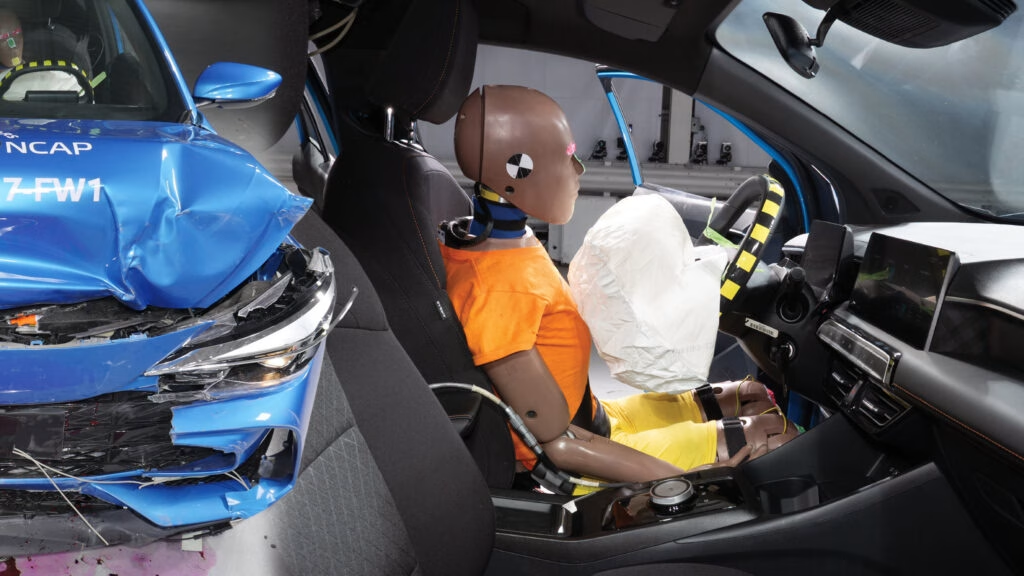What caused the MG 3’s seat latch failure during Euro NCAP testing?
When Euro NCAP put the MG 3 through its paces, something happened that’s never been seen in the program’s 27-year history: the driver’s seat latch failed during a crash test. In plain English, the mechanism that locks the seat in place didn’t hold up under the force of a frontal offset collision. The result? The seat twisted mid-impact, which not only made things worse for the crash test dummy’s legs but also caused its head to bottom out in the airbag and hit the steering wheel. It’s a textbook example of how a single small component can unravel a car’s entire safety system in a split second.
Euro NCAP’s engineers double-checked the latch before testing, ruling out any setup mistakes. MG initially suggested the seat hadn’t been latched properly, but that theory didn’t hold water. The failure was all down to the design and robustness of the latch itself—a critical weak link in the chain.
How did this affect the MG 3’s safety rating and injury risk?
Despite the seat latch fiasco, the MG 3 still walked away with a four-star Euro NCAP rating. That might sound surprising, but here’s the catch: Euro NCAP’s current scoring system doesn’t allow for a direct penalty tied to a single component failure, even if it’s a big one. So, the MG 3’s overall structure and safety tech kept its score afloat.
But let’s not sugarcoat it. The seat movement meant the dummy’s lower legs took a bigger hit, earning a “poor” rating for lower leg protection. And because the head pushed through the airbag and struck the steering wheel, head protection was only rated “adequate.” In a real-world crash, this could mean a higher risk of serious injury for drivers, especially those who are taller or shorter than average, since the seat’s movement throws off the entire restraint system.
What steps is MG taking to fix the problem?
MG isn’t sweeping this under the rug. The company has pledged to redesign the seat latch, with updated parts rolling out on production lines from August 2025. They’re also tweaking the driver’s airbag starting in October. Euro NCAP will retest the updated MG 3, and if the fix doesn’t pass muster, the results will go straight to the European Vehicle Type Approval office—a move that could trigger a recall if regulators decide it’s necessary.
This kind of transparency and willingness to address the issue is a good sign, but it also highlights how quickly carmakers need to respond when a safety flaw is exposed in public testing.
Why did the MG 3 still score four stars, and what does that mean for buyers?
Here’s where things get a bit murky for consumers. The MG 3’s four-star rating puts it near the top of its class on paper, with 74% for Adult Occupant protection, 74% for Child Occupant protection, 81% for Vulnerable Road Users, and 69% for Safety Assist. These numbers reflect improvements over previous versions, especially in driver assistance features.
But the rating doesn’t tell the whole story. Because Euro NCAP’s rules don’t currently dock points for individual component failures, a car can still score well overall even if there’s a glaring safety issue. That’s why Euro NCAP is now reviewing its protocols, with plans to introduce stricter penalties for failures in safety-critical parts. In the meantime, buyers need to look beyond the stars and dig into the details of each test report.
What advice does Euro NCAP have for shoppers considering the MG 3?
Dr. Aled Williams, Euro NCAP’s Programme Director, didn’t mince words: finding a seat latch failure in a 2025 model is deeply troubling. He recommends that buyers consider alternatives to the MG 3 until the issue is fully resolved and retested. Euro NCAP’s website offers a comparison tool to help shoppers find the safest cars in their segment.
If you’re in the market for a small hybrid hatchback, the MG 3’s main rival is the Toyota Yaris Hybrid, but there are plenty of other options like the Renault Clio, Peugeot 208, Opel Corsa, and VW Polo. Until MG’s fix is proven in a fresh round of tests, it’s wise to keep your options open.
How does this incident change the way safety ratings are handled?
This isn’t just a blip for MG—it’s a wake-up call for the entire industry. Euro NCAP is already working on updates to its scoring system to make sure that critical failures like this can’t slip through the cracks. In the future, a single weak link—whether it’s a seat latch, airbag, or another vital part—could drag down a car’s overall rating, no matter how well it performs elsewhere.
It’s a reminder that safety isn’t just about high-tech features or crash-test scores. Sometimes, the smallest part can make the biggest difference.
What should buyers do while waiting for updates?
If you’re set on an MG 3, check the build date and ask your dealer about the updated latch and airbag. Don’t be shy about requesting proof that your car has the fix. And if you’re on the fence, use this as a chance to compare safety reports across the models you’re considering. Euro NCAP’s database is a goldmine for this kind of research.
The big takeaway? Car safety isn’t about perfection—it’s about smarter adjustments. Start with one change this week, and you’ll likely spot the difference by month’s end. Whether that’s asking tougher questions at the dealership or reading the fine print in crash test reports, a little extra effort goes a long way toward keeping you and your loved ones safe on the road.

